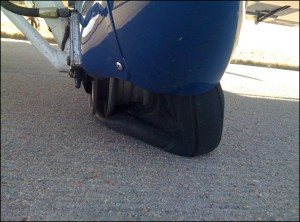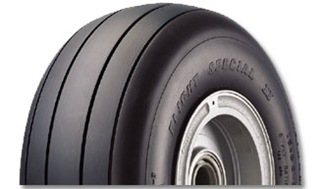Ron, the blogger behind the House of Rapp blog, has written a detailed post with everything you could possibly want to know about aircraft tyres (or tires if you are outside the UK…) as they (along with constant-speed propellers) are one of his soapbox issues. Moreover, aircraft tyres are an important part of an aircraft that is often ignored – just like the tyres of your car.
However, ignoring your GA aircraft’s tyres can be dangerous as Ron noted that:
…tire failure on the takeoff or landing roll can lead to loss of directional control, runway excursion, and/or a ground loop. These things are unlikely to be fatal but are frequently embarrassing and inconvenient as they’ll shut down the runway for a while. I’ve had several of those in my career.
Ron then told the story of how he had stopped for cheap fuel in Limon, Colorado, on a paved but little-used airstrip on the edge of a small town. After he refueled and started to taxi, the left main tyre slowly deflated and as soon as his foot came off the brakes, the aircraft weathervaned into the wind – taking off the tire rim and making the aircraft immovable. At this time, the sun began to set and Ron was sitting in an unlighted biplane on a runway that luckily was not exactly a popular place for night landings.
 Ron then pointed out that the FAA has recently issued Safety Alert for Operators (SAFO) bulletin 11001 entitled “The Importance of Properly Inflated Aircraft Tires.” The bulletin noted that research has shown that transport-category aircraft can lose as much as 5% of tyre pressure per day under typical operations – meaning it would only take a few days before the tyres require servicing. In addition, Gulfstream has recently reviewed tyre safety “best practices” in their weekly Breakfast Minutes publication which also referenced the Goodyear Aircraft Tire Care and Maintenance publication.
Ron then pointed out that the FAA has recently issued Safety Alert for Operators (SAFO) bulletin 11001 entitled “The Importance of Properly Inflated Aircraft Tires.” The bulletin noted that research has shown that transport-category aircraft can lose as much as 5% of tyre pressure per day under typical operations – meaning it would only take a few days before the tyres require servicing. In addition, Gulfstream has recently reviewed tyre safety “best practices” in their weekly Breakfast Minutes publication which also referenced the Goodyear Aircraft Tire Care and Maintenance publication.
There are plenty of good reasons to be issuing alerts about tyres as Ron also noted that tyre failures have already caused a variety of high-profile jet accidents. These accidents include Air France flight 4590, Mexicana flight 940, Nigeria Airways flight 2120 and the 2008 crash of a Lear 60 in South Carolina. Moreover, improperly inflated tyres in turbine aircraft are more likely to lead to expensive damage or even catastrophic consequences because these aircraft have higher speeds and are heavier.
Ron’s entire post is packed with useful information about aircraft tyres and hence, its well worth reading.
